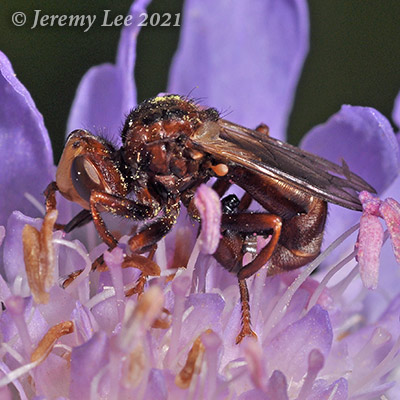
 |
|
Scientific Classifications explained » Amphibians » Ants » Aphids » Bees » Beetles » Birds » Bugs » Butterflies » Caterpillars » Damselflies » Dragonflies » Earwigs » Flies » Frog/Leafhoppers » Fungi » Galls » Grasshoppers » Harvestmen » Hoverflies » Lacewings » Ladybirds » Leaf Mines » Lichens » Mammals » Millipedes » Mosses » Moths » Sawflies » Slugs » Snails » Spiders » Trees & Shrubs » Wasps » Wild Flowers » Woodlice » Postboxes |
UK Nature > Flies > Sicus ferrugineus

Scientific Name: Sicus ferrugineus Common Name: Thick-headed Fly Scus ferrugineus, more commonly known as a Thick-headed Fly, is a species of fly from the genus Sicus in the family Conopidae. The adults grow up to 8–13 millimetres and the body is mainly reddish-brown or yellow-brown. The head is yellow, quite large and inflated-looking, with a kind of bubble at the front and narrow cheeks. The short antennae are brown, their second segment has the same length or it is longer than the third. The large eyes are reddish. The legs and also the last abdomen segments are often darkened. The abdomen is long, round in cross-section, the seventh segment is oblong and conical. When in resting position the abdomen is usually folded forward. They usually are found frequenting hedgerows and flower meadows from May through to September. They feed on nectar or pollen of various flowering plants, very often Asteraceae species. Widespread and fairly frequent in Britain. |
|

https://www.uknature.co.uk is a website dedicated to showing the immense diversity of UK nature and wildlife. Our vast range of habitats, from lowland arable to snow covered mountains, from storm-ravaged coastlines to peaceful inland freshwater lakes and rivers, from dry, sandy heaths to deciduous and coniferous forests, all these habitats contribute to the abundance of UK nature. We have wild birds in huge numbers either residing or visiting our shores (597 recorded species as at July 2013) and we must also not forget the humble back garden with its grass lawns, flower beds filled with nectar rich flowers, shrubs and trees, all designed to attract huge numbers of insects such as bees, moths, butterflies and hoverflies; and finally the small ponds which provide safe havens for frogs, toads, newts and even slow worms and grass snakes. www.uknature.co.uk is the showcase for my personal passion, photographing uknature in all its glory. I sincerely hope you all enjoy the fruits of my labours. This site and all images contained therein is © Jeremy Lee 2004 - 2025. All Rights Reserved. Site design by Jeremy Lee. Site development & IT Support by Stuart Lee. |